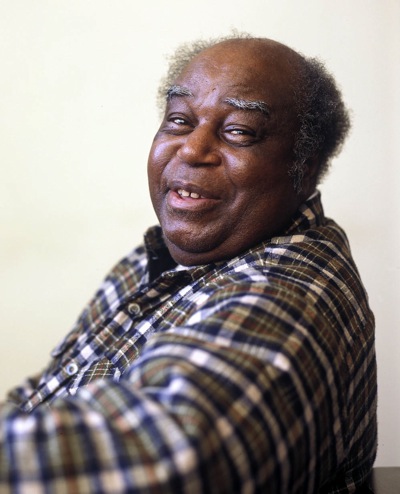
Charlie E. Nelson
(1937–2009)
Teacher and Band Leader
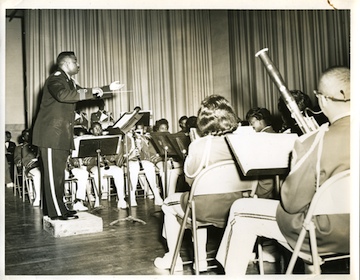
Charlie Nelson moved from Danville in late summer 1963 to become a band director, above, and teacher in Hampton, Virginia.
Photo: Courtesy of Charlie Nelson
The confusion seemed to lessen for Charlie Nelson when he moved to a larger metropolitan area and the civil rights movement played out on the national stage. In August 1963, approximately 250,000 people participated in the March on Washington, and Martin Luther King, Jr., made his famous “I Have a Dream” speech on the steps of the Lincoln Memorial. By that time, Mr. Nelson had taken a position teaching and directing band at a high school in Hampton, Virginia. In the library of the segregated school, he gathered with colleagues and students to witness the march as a member of a much broader national community: the television audience. It was a peaceful march with little visible conflict, and the pictures he saw on television made Charlie Nelson proud. “I was happy about the approach that my people and the black people in America had taken at that time in Washington.”
“I was happy that we were taking a stand to do something good for ourselves and something that we had been deserving for a long time.”
—Charlie E. Nelson
- Interview Excerpts
- Related Resources
- Biography
These selections come from an oral history of Charlie E. Nelson conducted by Gladys Hairston in Danville, Virginia, on April 23, 2005. Ms. Hairston is a 2004 graduate of the College of Arts & Sciences at the University of Virginia.
Loyal Baptist Church: “In the Heart of the Community”
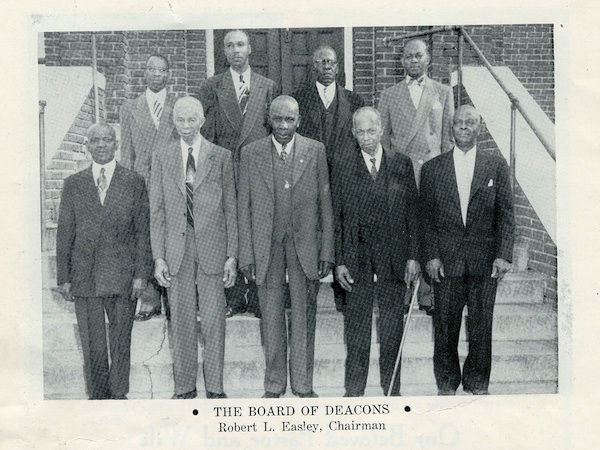
The Loyal Baptist board of deacons is pictured here in 1952, when Charlie Nelson became a member of the church.
Photo: Courtesy of Cleophia Fitzgerald
Charlie E. Nelson joined Loyal Baptist Church in 1952, the year the church at Holbrook and Gay streets celebrated its eighty-sixth anniversary. The Reverend Doyle John Thomas was minister; Robert L. Easley was chairman of the board of deacons; and John Gorrell was chairman of the board of trustees. In its anniversary program, Loyal Baptist was described as “the Church in the heart of the Community for the hearts of the people.”
A woman that I considered a saint brought me and quite a few people in my community around Loyal Baptist to Sunday school in 1947. She brought us here from various streets and put us in Sunday school classes here. Most of us stayed at this church from the time Miss Edith Davis brought us until now. I joined this church in January 1952 as a result of her bringing us here. Most of those people that she brought, as I said, stayed. Some of us are members now, who are still living.
Earliest memories of attending Loyal Baptist were the picnics. My first teacher here was Mr. Rudd, Deacon Rudd. My first pastor was Doyle J. Thomas. My second Sunday school teacher was Mary Alice Wilson. And there are all of the students and friends that I met here, from 1947 up until present.
[Sunday school teachers] played a very significant role in my life because they made me aware of the ways of the Bible and the ways that we should be as citizens and the ways that we should perform as members in the church. They also taught us behavior and obedience and everything that an outstanding citizen should be in the church and in the community.
Making Music over a Lifetime
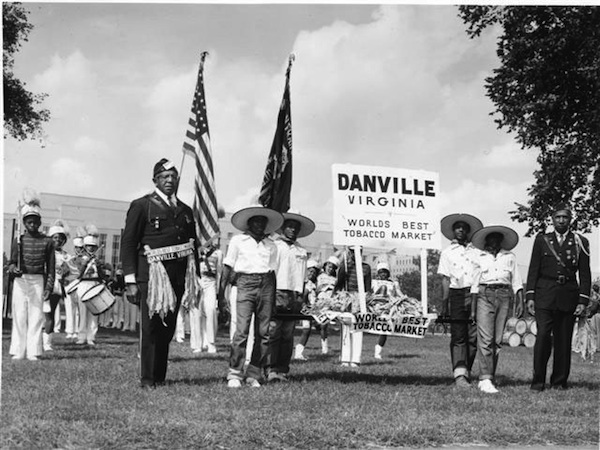
Above, the Danville Junior Drum and Bugle Corps participated in a 1940 American Legion competition in Boston, Mass.
Photo: Courtesy of the National Tobacco and Textile Museum, Danville
Influenced by his brother, a member of American Legion Post 29 Drum and Bugle Corps, Charlie Nelson started playing the bugle when he was ten years old. His passion for music continued through his teens and into adulthood. As a retiree, he still made music part of his life, playing with the Starmont Swing Band in his hometown.
I got started in music from the American Legion Post 29 Drum and Bugle Corps. I used to listen to them perform and see them perform. My oldest brother was a member. I followed right in his footsteps and started playing the bugle when I was about ten years old. My interest in music continues up until this day.
There were an awful lot of contests when I was coming along as a child, in my early teens and what have you. I am still playing in the dance bands and in churches now. That never stopped. It continued from the time I started playing music at about ten years old until now.
[Music] meant an awful lot to me because of observing the musicians as they played. There was a band over in Burlington, North Carolina, called the Jordan Cellars High School Band; they would come here every year in May. The American Legion would have bands come here from around Virginia and North Carolina to perform in the month of May. I developed an interest and listened to them and [that interest] continues from that time up until this.
The Echoes of Soul: An Integrated Sound
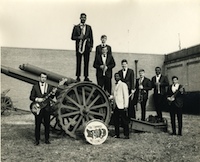
Charlie Nelson, second from left, played trumpet in the integrated Echoes of Soul band.
Photo: Courtesy of Charlie E. Nelson
Music was often a bridge between the races. In the 1950s, black and white teenagers danced to the beat and rhythms of Fats Domino and Little Richard. In the 1960s, when the Echoes of Soul needed a trumpet player, Charlie Nelson’s facility with a horn was more important than the color of his skin.
I taught music here with the Post 29 Drum and Bugle Corps before going to college. I attended the Florida Agricultural and Mechanical University in Tallahassee, Florida, and received my bachelor’s degree there. I also received my master of administration degree from Hampton University. All of that continued to be a part of my working with the community, especially in music.
The Night Hawks was a group that I performed with around here when I was a teenager. Most of the members are deceased at this time, but a few of them are still around, in different parts of the country. The Echoes of Soul was an integrated band that I performed with in Hampton. I also performed with John Van and the Swinging Gents in Norfolk and the Studio One Band in Norfolk; and there’s the band that I’m performing with now, the Starmont Swing Band in Danville.
“I Was Happy that We Were Taking a Stand”

Charlie Nelson moved from Danville in late summer 1963 to become a band director, above, and teacher in Hampton, Virginia.
Photo: Courtesy of Charlie E. Nelson
Mr. Nelson recalls his reactions to the 1963 civil rights demonstrations in Danville and the March on Washington for Jobs and Freedom. He didn’t participate in the protests or attend the march, but he was proud that African Americans were taking a stand for the rights they had long deserved.
I came home from Florida in ’63. … Dr. Martin Luther King [Jr.] and a lot of our preachers and church people in this area, in this community, were into the business of trying to free our people for certain rights they should have deserved. Here it was kind of mixed up. It was mixed up for the black race and for the white race, because we were moving into something that was different. One group was trying to get something that they believed they deserved. Another group was trying to stop them from getting that. There was really a conflict and a mixed-up situation at that time. Everybody was confused up until the point where we went up to the March on Washington in August of ’63.
I didn’t go to that march. That was my first year of teaching. I’m talking about August of ’63. That was my first year of teaching down at Hampton, so we caught the march on television in the library there and observed it from our library, but I was not able to attend.
I was happy that we were taking a stand to do something good for ourselves and something that we had been deserving for a long time. I was very happy about the approach that my people and the black people in America had taken at that particular time in Washington.
Charlie E. Nelson, interview by Gladys Hairston, April 23, 2005, transcript, Danville Public Library and Mary Blount Library at Averett University, Danville, Virginia.
Click on the image thumbnails below to view a larger version of the image.
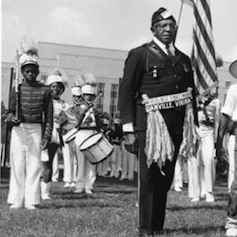
DANVILLE JUNIOR DRUM AND BUGLE CORPS (1940).
At thirteen, Charlie Nelson was named the Outstanding New Drumming and Bugle Corps Member at American Legion Post 29 in Danville. His older brother, James Nelson, was also a member and traveled with the Junior Drum and Bugle Corps to Boston, Massachusetts, in 1940 to compete for a national championship at the American Legion Convention, left. The corps advertised the Danville tobacco market with banners and bunches of tobacco leaves tied at their belts.
Photograph. Courtesy of the National Tobacco and Textile Museum, Danville, Virginia.
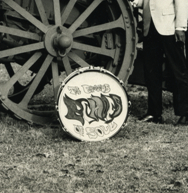
ECHOES OF SOUL BAND (1960s).
When Charlie Nelson moved to Hampton, Virginia, in 1963 to teach, he still found a way to practice his music. He was a high school teacher and school band director and, in the evening, performed with the integrated Echoes of Soul band, as well as with the Studio One Band and the Swinging Gents in Norfolk. The Echoes of Soul was organized at Fort Eustis, a U.S. Army installation in Newport News, and played soft and hard rock. The musicians’ hometowns ranged from Virginia to California. Charlie Nelson is second from left.
Photograph. Courtesy of Charlie E. Nelson, Danville, Virginia.
“THE LEGEND OF DANVILLE” (1963).
Music, which was so important to Charlie Nelson, played a major role in African-American life from the days of slavery, and it was an integral part of the 1963 civil rights demonstrations. “The Ballad of Buford Holt” and “The Legend of Danville” were freedom songs written by Matthew Jones, Student Nonviolent Coordinating Committee (SNCC) field secretary and director of the SNCC Freedom Singers. Traditional hymns, sermon-songs, and claps and responses also helped inspire and unify demonstrators as they prepared to face hostile white authorities, police dogs, and fire hoses. Click to hear “The Legend of Danville.” [Click to hear “The Legend of Danville” with lyrics.]
“The Legend of Danville.” 1963. Courtesy of Matthew Jones.
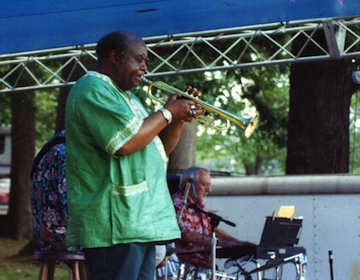
In his retirement, Charlie Nelson performed with the Starmont Swing Band in his hometown of Danville.
Photo: Courtesy of Charlie E. Nelson
CHARLIE E. NELSON, AN EDUCATOR AND MUSICIAN, was born July 6, 1937, in Danville. He attended Westmoreland Elementary School and John M. Langston High School, graduating from high school in 1956. Afterward, he taught music with the American Legion Post 29 Drum and Bugle Corps while working in the city’s tobacco factories. He later enrolled at Florida Agricultural and Mechanical University, where he received a bachelor’s degree in 1963. From 1963 to 1991, Mr. Nelson worked as a teacher and band director in the Hampton, Virginia, public schools. Upon retirement, he returned to Danville, where, with various groups, he continued to play his beloved music “as an enjoyment to our souls and as an enjoyment playing for the community.” Mr. Nelson died on December 14, 2009.
